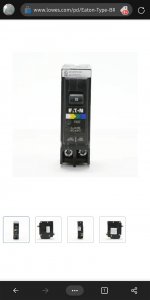Just guessing, but one thing that might cause this is some unwanted resistance between the neutral and EGC on the load side of the home run. The more load current there is from incandescent lamp loads, the more voltage drop there will be along the neutral conductor and therefore more voltage across a N-G resistance. This increased voltage across the resistance would cause a higher N-G leakage current, and if it exceeds 6 mA it could trip the GFCI function of the breaker.
There is a grounded neutral detection function in GFCI's, but it's only required to trip when there's a very low N_G fault resistance, typically less than a few ohms. But, for example, if you had a 0.25V drop on the neutral conductor and a 40 ohm N-G resistance, that would cause over 6 mA of leakage current and trip the GFCI.
One suggestion is to try a GFCI only breaker and see if it still trips. If it does trip, then with all loads switched off and the breaker off, you might remove the load neutral from the breaker and then measure the resistance between the neutral and EGC. It should be a very high resistance / open circuit.


